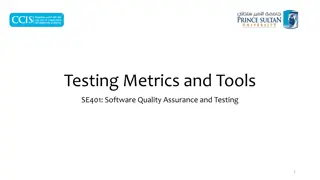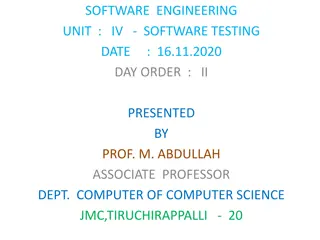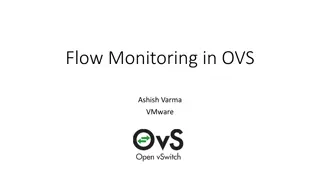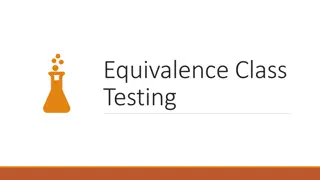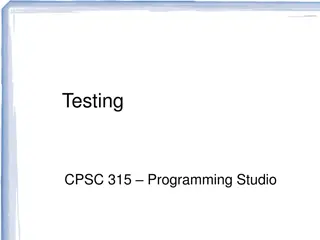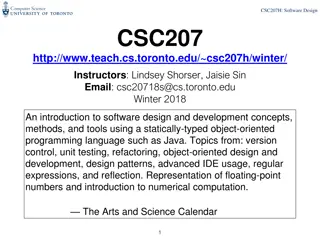Control Flow Testing Techniques in Software Design
Explore the significance of control flow testing in software design, focusing on path selection criteria, test case generation, and path execution. Learn how control flow testing helps in revealing defects efficiently and effectively, improving the overall quality of software systems.
Download Presentation

Please find below an Image/Link to download the presentation.
The content on the website is provided AS IS for your information and personal use only. It may not be sold, licensed, or shared on other websites without obtaining consent from the author.If you encounter any issues during the download, it is possible that the publisher has removed the file from their server.
You are allowed to download the files provided on this website for personal or commercial use, subject to the condition that they are used lawfully. All files are the property of their respective owners.
The content on the website is provided AS IS for your information and personal use only. It may not be sold, licensed, or shared on other websites without obtaining consent from the author.
E N D
Presentation Transcript
Chapter Five: Test Case Design Techniques Control Flow Testing Sem. II - 2020 Department of Software Engineering ITSC-AAIT Software Design, Verification and Validation 1
Basic Idea Two kinds of basic program statements Assignment statements (Ex. x = 2*y; ) Program Conditions (Ex. if(), for(), while(), ) Control flow Successive execution of program statements is viewed as flow of control. Conditional statements alter the default flow. Program path is the execution instance of program unit. It Is the execution of a sequence of instructions from the entry point to the exit point of a program unit. There can be a large number of paths in a program. Program path could be characterized by a pair of (input, expected output). Executing a path requires invoking the program unit with the right test input. Software Design, Verification and Validation 2
Basic Idea Mere execution of large number of paths is costly and ineffective in revealing defects. Paths are chosen by using the concepts of path selection criteria. Often tools are used to automatically generate test inputs from program paths. Control Flow Testing Control flow testing is a kind of structural testing, which is performed by programmers to test code written by them (even the smaller units, functions) Test cases for control flow testing are derived from the source code, such as a program unit (e.g., a function or method), rather than from the entire program. The main idea in control flow testing is to appropriately select a few paths in a program unit and observe whether or not the selected paths produce the expected outcome. Executing few paths in a program unit could show the behavior of entire unit. Software Design, Verification and Validation 3
Outline of Control Flow Testing Inputs: The source code of a program unit and a set of path selection criteria Example of Path Selection Criteria Select paths such that every statement is executed at least once. Select paths such that every conditional statement, for example, an if() statement, evaluates to true and false at least once on different occasions. Path selection should follow generation of a control flow graph .(in which visual representation of all paths in a program unit is performed). In automated test generation, a compiler can be modified to produce a CFG. Software Design, Verification and Validation 4
Outline of Control Flow Testing Software Design, Verification and Validation 5
Outline of Control Flow Testing Selection of paths Enough entry/exit paths are selected to satisfy path selection criteria. Generation of test input data Two kinds of paths Executable path: There exists input so that the path is executed. Infeasible path: There is no input to execute the path. Solve the path conditions to produce test input for each path. Software Design, Verification and Validation 6
Control Flow Graph Three symbols are used to construct a CFG. Each computation and decision box should be labeled with a unique integer. The two branches of a decision box are labeled with T and F. Software Design, Verification and Validation 7
Control Flow Graph Software Design, Verification and Validation 8
Control Flow Graph Software Design, Verification and Validation 9
Control Flow Graph Detail CFG Software Design, Verification and Validation 10
Control Flow Graph Software Design, Verification and Validation 11
Control Flow Graph Software Design, Verification and Validation 12
Paths in a Control Flow Graph A few paths from average calculator Path 1: 1-2-3(F)-10(T)-12-13 Path 2: 1-2-3(F)-10(F)-11-13 Path 3: 1-2-3(T)-4(T)-5-6(T)-7(T)-8-9-3(F)-10(T)-12-13 Path 4: 1-2-3(T)-4(T)-5-6-7(T)-8-9-3(T)-4(T)-5-6(T)-7(T)-8-9-3(F)-10(T)-12- 13 Software Design, Verification and Validation 13
Path Selection Criteria Program paths are selectively executed. The concept of path selection criteria is used to answer this question. What paths do I select for testing? Advantages of selecting paths based on defined criteria: Ensure that all program constructs are executed at least once. Repeated selection of the same path is avoided. One can easily identify what features have been tested and what not. Path selection criteria Select all paths. Select paths to achieve complete statement coverage. Select paths to achieve complete branch coverage. Select paths to achieve predicate coverage. Software Design, Verification and Validation 14
Path Selection Criteria All-Path Coverage Criterion All-path coverage criterion: Select all the paths in the program unit under consideration. The openfiles() unit has 25+ paths. Selecting all the inputs will exercise all the program paths. Software Design, Verification and Validation 15
Path Selection Criteria Statement Coverage Criterion Statement coverage means executing individual program statements and observing the output. 100% statement coverage means all the statements have been executed at least once. Cover all assignment statements. Cover all conditional statements. Less than 100% statement coverage is unacceptable. The basic problem is to select a few feasible paths to cover all the nodes of a CFG in order to achieve the complete statement coverage criterion. Software Design, Verification and Validation 16
Path Selection Criteria Statement Coverage Criterion Software Design, Verification and Validation 17
Path Selection Criteria Branch Coverage Criterion A branch is an outgoing edge from a node in a CFG. A condition node has two outgoing branches corresponding to the True and False values of the condition. Covering a branch means executing a path that contains the branch. 100% branch coverage means selecting a set of paths such that each branch is included on some path. Software Design, Verification and Validation 18
Path Selection Criteria Branch coverage criterion Software Design, Verification and Validation 19
Path Selection Criteria Predicate coverage criterion Achieve both statement coverage and branch coverage. If all possible combinations of truth values of the conditions affecting a path have been explored under some tests, then we say that predicate coverage has been achieved. We need to design just two test cases to achieve both statement coverage and branch coverage. Software Design, Verification and Validation 20
Generating Test Input Having identified a path, a key question is how to make the path execute, if possible. i.e Generate input data that satisfy all the conditions on the path. Key concepts in generating test input data Input vector - is a collection of all data entities read by the routine whose values must be fixed prior to entering the routine. E.g Arguments, Global variables and constants, Files, Contents of registers in assembly language programming, network connections and Timers Example: An input vector for openfiles() consists of individual presence or absence of the files files1, file2, and file3. Example: The input vector of ReturnAverage() is <value[], AS, MIN, MAX> Software Design, Verification and Validation 21
Generating Test Input Key concepts in generating test input data Predicate A predicate is a logical function evaluated at a decision point. Example: ti < AS is a predicate in AverageCalculator Example: The construct OB is a predicate Software Design, Verification and Validation 22
Generating Test Input Key concepts in generating test input data Path Predicate A path predicate is the set of predicates associated with a path. E.g for ReturnAverage( .. ) Path: 1-2-3(T)-4(T)-5-6(T)-7(T)-8-9-3(F)-10(T)-12-13. Path Predicate ti < AS value[i] != -999 value[i] >= MIN value[i] <= MAX ti < AS tv > 0 True True True True False True Software Design, Verification and Validation 23
Generating Test Input Key concepts in generating test input data Predicate Interpretation A path predicate may contain local variables. Example: <i, ti, tv> in ReturnAverage() s path are local variables. Local variables play no role in selecting inputs that force a path to execute. Local variables can be eliminated(replaced by the element of input vectors) by a process called symbolic execution. Hence, Predicate interpretation is defined as the process of symbolically substituting operations along a path in order to express the predicate solely in terms of the input vector and a constant vector. A predicate may have different interpretations depending on how control reaches the predicate. Software Design, Verification and Validation 24
Generating Test Input Key concepts in generating test input data Predicate Interpretation Example: ? ? ? This expression is defined over the input vector <x1, x2> and constant vector <0,7> Software Design, Verification and Validation 25
Generating Test Input Key concepts in generating test input data Path Predicate Expression An interpreted path predicate is called a path predicate expression. A path predicate expression has the following attributes. It is void of local variables. It is a set of constraints in terms of the input vector, and, maybe, constants. Path forcing inputs can be generated by solving the constraints. If a path predicate expression has no solution, the path is infeasible. Software Design, Verification and Validation 26
Generating Test Input Key concepts in generating test input data Path predicate expression (Return Average()) Path ? Predicate Expression ? Software Design, Verification and Validation 27
Generating Test Input Key concepts in generating test input data Path predicate expression Infeasible Path of Return Average( ) Path: 1-2-3(T)-4(F)-10(T)-12-13 Path Predicate Expression Software Design, Verification and Validation 28
Generating Test Input Key concepts in generating test input data Generating input data from a path predicate expression Path: 1-2-3(T)-4(T)-5-6(T)-7(T)-8-9-3(F)-10(T)-12-13. Path Predicate Expression 0 < AS value[0] != -999 value[0] >= MIN value[0] <= MAX 1 < AS 1 > 0 One can solve the above equations to obtain the following test input data AS = 1 MIN = 25 MAX = 35 Value[0] = 30 True True True True False True (1) (2) (3) (4) (5) (6) Software Design, Verification and Validation 29
Reading Software Testing and Quality Assurance: Theory and Practice Page [120-143] The Art of Software Testing Page [64 - 112 ] Software Design, Verification and Validation 30



